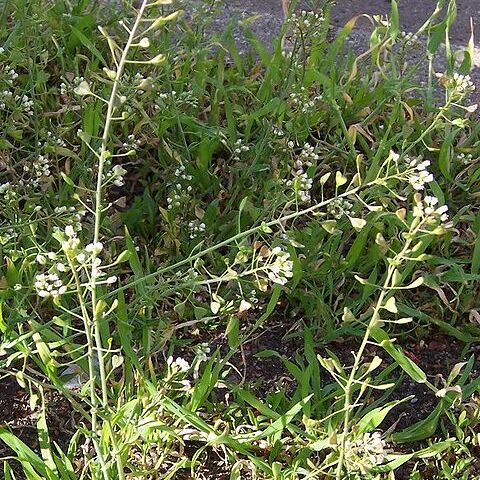Herbs annual or biennial. Trichomes sessile and stellate, sometimes mixed with simple or forked ones. Stems erect or ascending. Basal leaves rosulate, simple, usually pinnately lobed, lyrate, or runcinate, rarely entire or toothed. Cauline leaves sessile, auriculate or amplexicaul, entire, dentate, or sinuate. Racemes many flowered, ebracteate. Fruiting pedicels slender, ascending or divaricate. Sepals ovate or oblong, erect or ascending, glabrous or pubescent, base of lateral pair not saccate. Petals white, pink, red, or rarely yellowish, much longer or shorter than sepals, sometimes lacking; blade obovate or spatulate, apex obtuse; claw distinct from blade. Stamens 6, erect, tetradynamous; filaments not dilated at base; anthers ovate or oblong, obtuse at apex. Median glands absent; lateral glands 1 on each side of lateral stamen. Ovules (12-)20-40 per ovary. Fruit dehiscent silicles, obdeltoid to obdeltoid-obcordate, strongly flattened and angustiseptate, sessile; valves papery, prominently veined, strongly keeled; replum rounded; septum complete; style less than 1 mm, included or exserted from apical notch; stigma capitate, entire. Seeds uniseriate, wingless, oblong, plump; seed coat reticulate, mucilaginous when wetted; cotyledons incumbent.
Annual to short-lived perennials, small to medium-sized with taproot. Hairs simple, or forked, or branched. Racemes terminal, ebracteate, corymbose, with small flowers, in fruit loose. Sepals somewhat spreading, not saccate. Petals white, sometimes reddish or yellowish, ± clawed, rarely absent. Stamens 6; filaments linear; anthers ovoid, obtuse. Nectaries as semicircular glands at each side of each lateral stamen. Ovary dorsiventrally flattened, obovate in outline, with 10-40 ovules in each locule. Fruit a silicula, dehiscent, flat, with narrow septum, obtriangular to obcordate, valves keeled. Seeds numerous, not mucilaginous.
Annual to short-lived perennials, small to medium-sized, with a taproot. Hairs simple forked or branched. Racemes terminal, ebracteate, corymbose, with small flowers, in fruit lax. Sepals somewhat spreading, not saccate. Petals white, sometimes reddish or yellowish, ± clawed (rarely absent). Stamens 6; filaments linear; anthers ovoid, obtuse. Nectaries as semicircular glands at each side of each lateral stamen. Ovary dorsiventrally flattened, obovate in outline, with 10–40 ovules in each locule. Fruit a silicula, dehiscent, flat, with narrow septum, obtriangular to obcordate; valves keeled. Seeds numerous, not mucilaginous.
Annual or biennial taprooted herbs. Hairs simple and stellate, rarely 0. Stems erect, leafy. Lvs usually deeply pinnatifid, sometimes entire. Racemes ebracteate. Sepals erecto-patent, not saccate. Petals white or reddish, rarely 0. Stamens usually 6, sometimes fewer, without appendages. Lateral nectaries 4, paired at bases of single stamens; median nectaries 0. Style short; stigma small, capitate. Silicle obtriangular, angustiseptate; valves keeled, reticulately veined. Seeds oblong, not winged, up to 12 per locule.
Sep short-oblong, ascending; pet white, obovate; short stamens flanked by a pair of minute glands; ovary flat, obovate; ovules 6–many per locule; style very short; frs strongly flattened at right angles to the septum, triangular-obcordate, truncate to broadly notched at the summit, commonly narrowly winged distally; annual or biennial herbs, pubescent with stellate hairs, with a tuft of basal lvs and a few reduced cauline lvs on the branching stems. Monospecific.
Annual herbs. Inflorescence ebracteate. Sepals erect, non-saccate. Petals clawed (absent). Stamens 6. Nectariferous glands 4, 1 each side of lateral stamens. Stigma minute, capitate. Silicula dehiscent, keeled, notched; septum narrow. Seeds in two rows, to 15 per locule; radicle incumbent.
Silicule flattened-obcordate (rarely ovoid) with keeled, net-veined valves.
Basal leaves entire or pinnatifid, cauline amplexicaul.
Annual or biennial herbs with slender tap-root.
Seeds several in each loculus.
Flowers usually white.
Sepals not saccate.
Stamens 6.
Petals 4.

